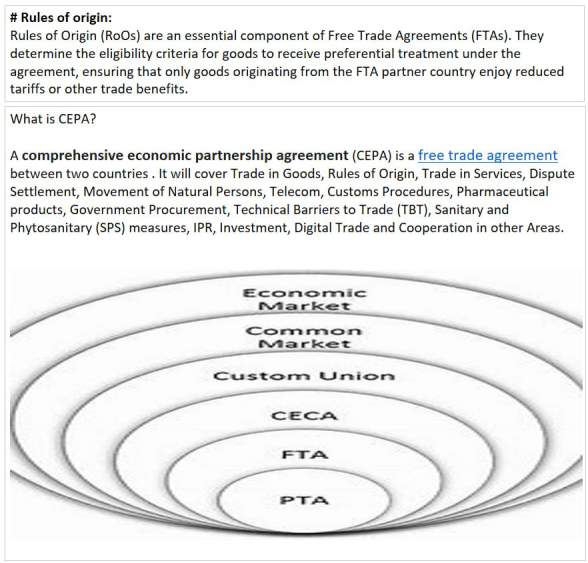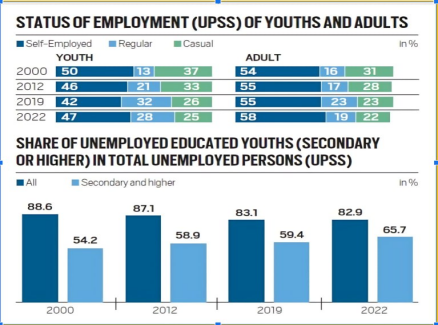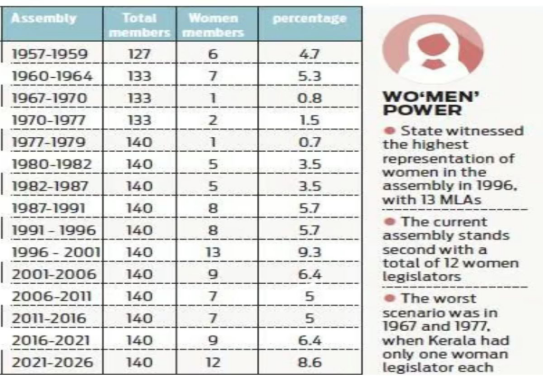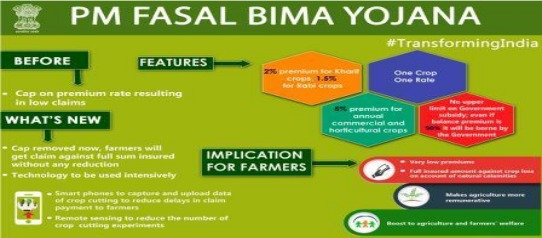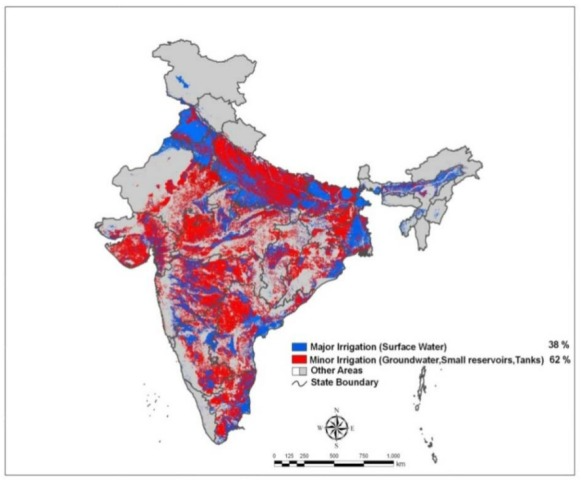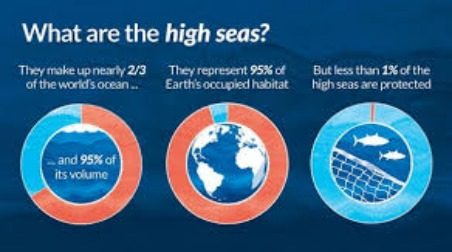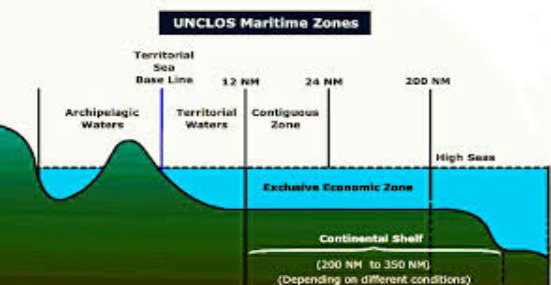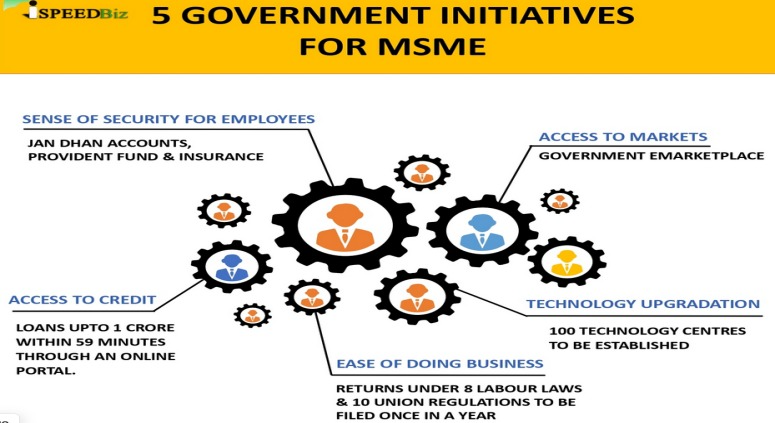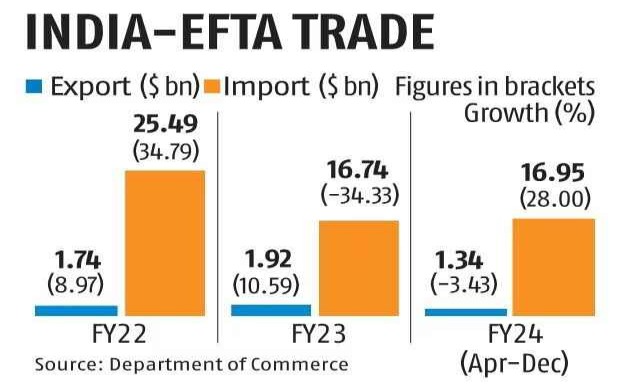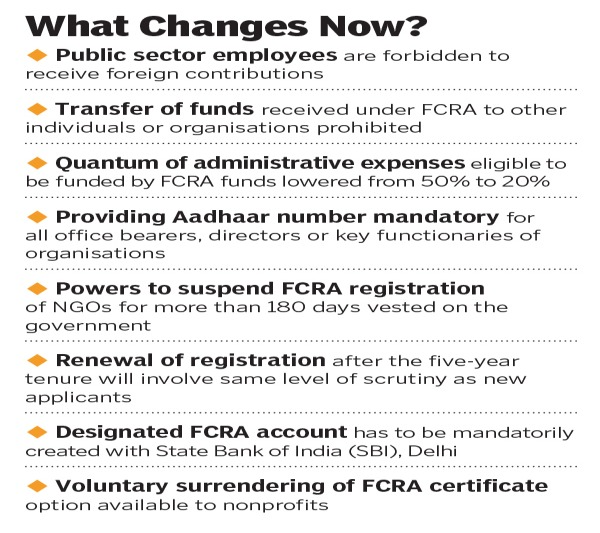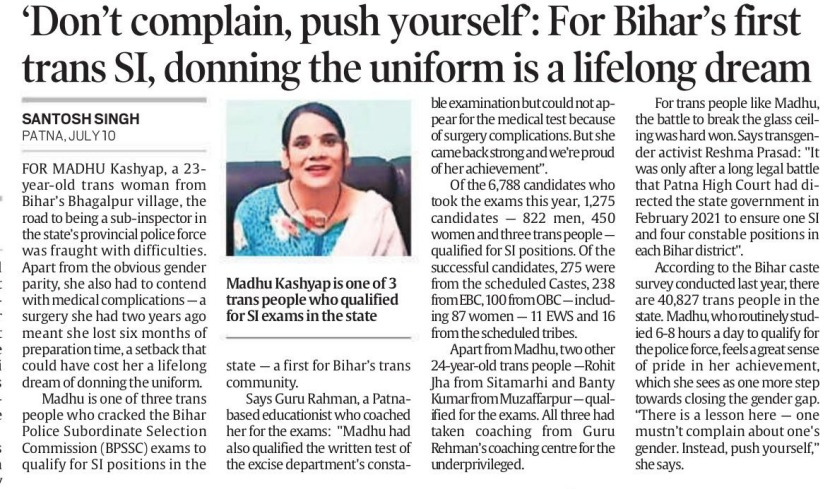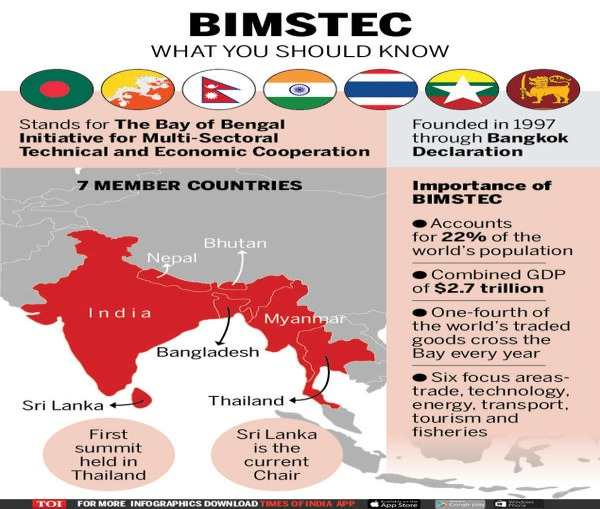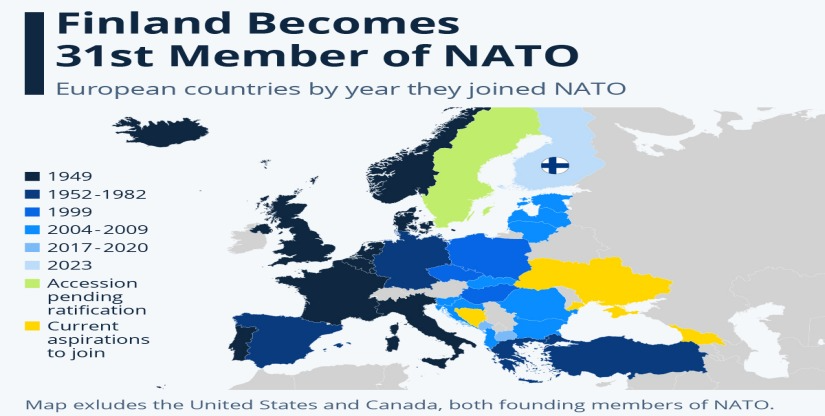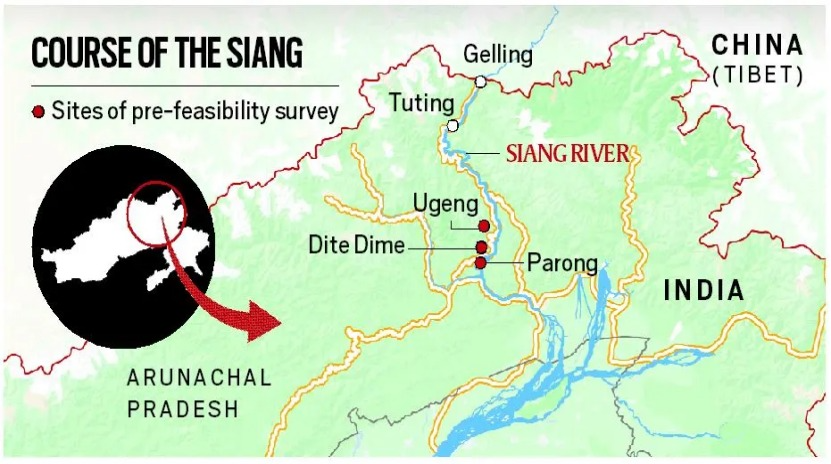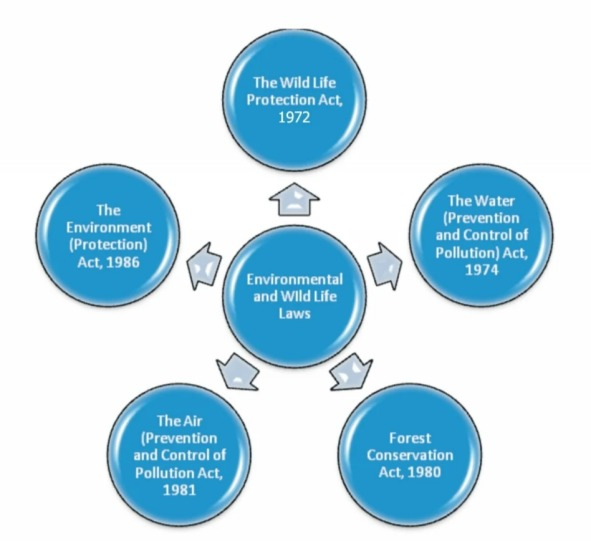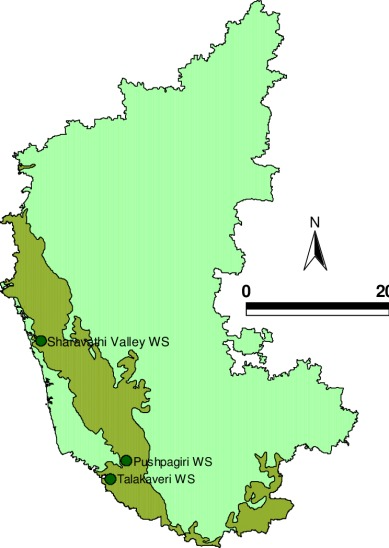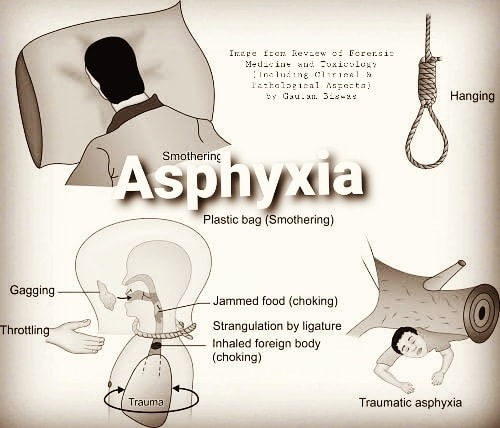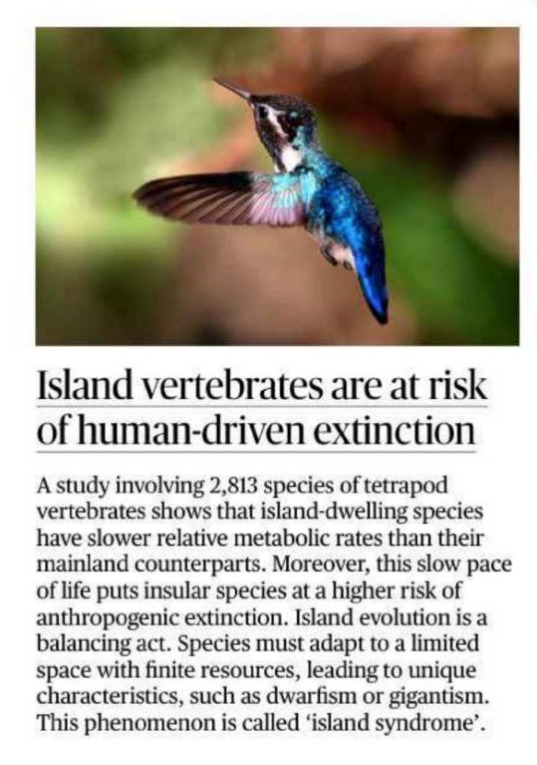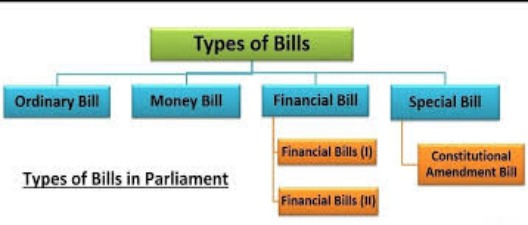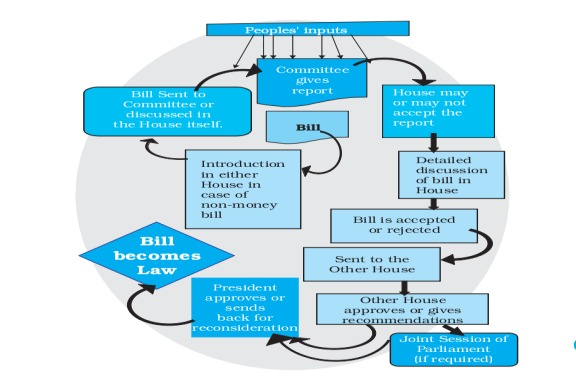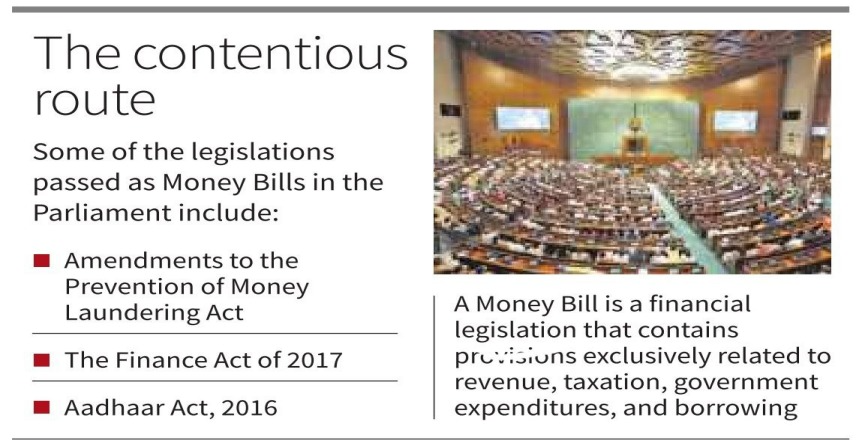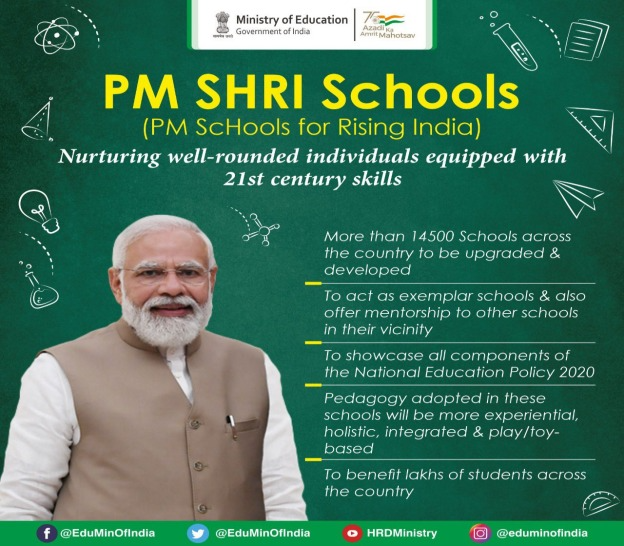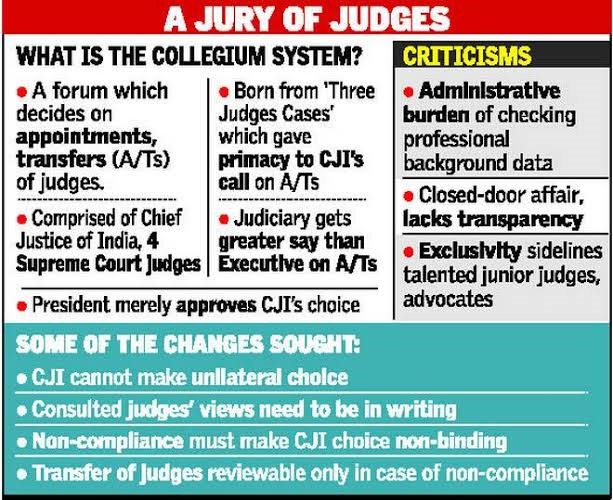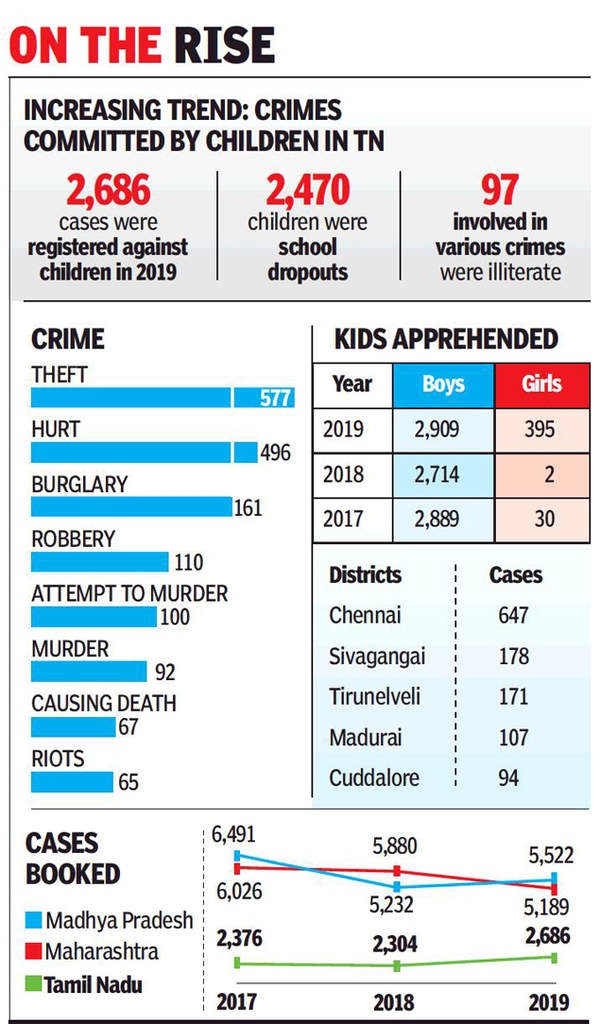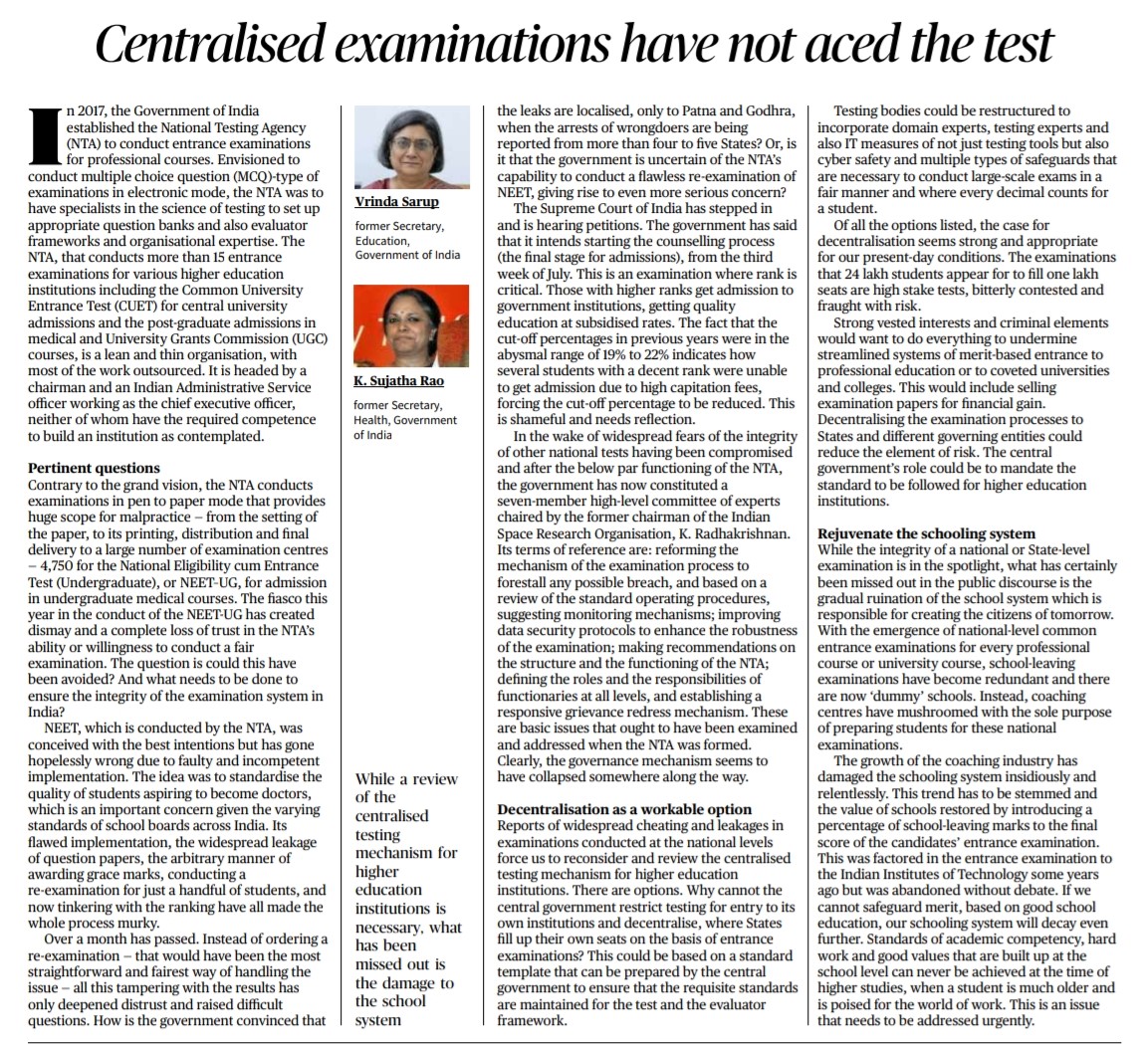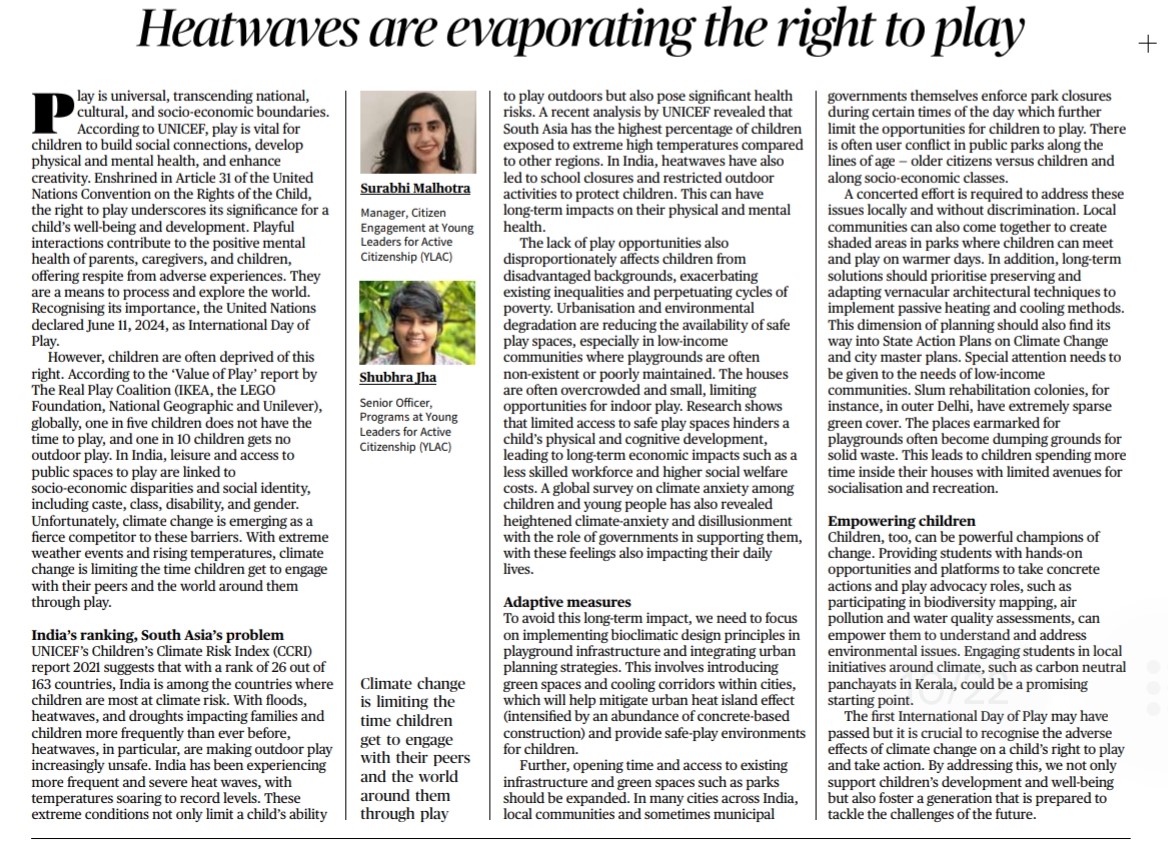SUPREME COURT ON RIGHT TO BAIL
Context: The Supreme Court ruled that denying bail to punish an accused violates their right to liberty (Article 21). This judgement came in an appeal regarding Javed Gulam Nabi Shaikh’s bail denial under UAPA, 1967.
Court ruling on Right to bail
Right to Bail vs Punishment: Denying bail solely to punish an accused violates Article 21. Bail is not a penalty, even in serious cases.
Presumption of Innocence: An accused is innocent until proven guilty. Prolonged detention without trial undermines this principle.
Speedy Trial: The state has a responsibility to ensure a speedy trial. If a speedy trial is unlikely, detaining the accused is unjustified and their right to bail is strengthened.
Balancing Act: Courts consider the severity of the offense, the possibility of tampering with evidence, and the flight risk of the accused while balancing it against their right to liberty.
Key Concepts:
Article 21: Guarantees protection of life and personal liberty. This includes the right to not be deprived of liberty arbitrarily or without following procedures established by law
Bail: The release of an accused person from custody on security (bail bond) pending trial.
Types of bail
Regular Bail: Granted after arrest (Sections 437 & 439 CrPC).
Anticipatory Bail: Granted before arrest for non-bailable offenses (Section 438 CrPC).
Statutory Bail: Automatic bail if charges aren’t filed within a set timeframe (Section 167(2) CrPC).
Note: In India, bail is not entirely a matter of right. The concept is more nuanced, with the right to bail depending on the type of offense:
Right to Bail:
Bailable Offenses: For offenses listed in the First Schedule of the Code of Criminal Procedure (CrPC), bail is a matter of right. This means upon presenting a valid bail bond, the accused is entitled to release.
Judicial Discretion on Bail:
Non-bailable Offenses: For offenses not included in the Schedule I of CrPC, bail is granted at the discretion of the court. The magistrate or judge considers the severity of the offense, flight risk, tampering evidence possibility, and the accused’s background before deciding.
Exceptions to Judicial Discretion:
Statutory Bail: This is a right, not a privilege. If the police or investigating agency fails to file a charge sheet within a specific timeframe mandated by law, the accused gets automatic bail.
SILVER IMPORT FROM UAE
Context: Concerns over increasing silver import from UAE through GIFT city meets rules of origin requirement specified in India-UAE pact when importers from other port fails to meet these.
Increased Silver Imports from UAE: India’s silver imports from the UAE have witnessed a significant surge in 2023-24, jumping by 210% to $10.7 billion.
Concerns over Duty Arbitrage: The rise in imports is attributed to duty arbitrage opportunities created by the India-UAE Comprehensive Economic Partnership Agreement (CEPA).
CEPA and Silver Duty: The CEPA (signed in 2022) reduces India’s import duty on silver to 0% over ten years, subject to meeting rules of origin requirements.
Analysis
Impact on Revenue: The report by the trade research body GTRI warns that unrestricted duty-free silver imports from UAE could lead to a significant loss of revenue for the Indian exchequer.
Potential Misuse of CEPA: GTRI expresses concerns that some importers might be exploiting loopholes in the CEPA rules of origin to benefit from duty concessions. They have called for stricter verification measures.
Disruption of Traditional Import Practices: The report highlights a potential disruption of traditional import practices and market dynamics due to a shift towards Dubai as a primary source for silver imports.
Recommendations by GTRI: GTRI suggests renegotiating the CEPA terms to nullify the duty arbitrage and recommends stricter checks on Dubai exporters’ claims regarding value addition. They also advice investigating potential conflicts of interest between import and export firm
FACT CHECK
3.1 Data on employment
Context: Employment data from centre’s periodic labour forced survey and the centre for monitoring Indian economy
Official Unemployment rate is 3.2%.
Agriculture accounts for 46% of employment with GDP contribution of less than 20% .
Share of formal sector in unemployment in non agricultural jobs is only 25%.
Only 21% of labour force has a ‘salaried’ job.
Share of employment in rural areas has remained at 67% between 2018 to 2023, indicating stalled rural to urban migration
3.2 Representation of women in Loksabha
FOR EXAMPLE….
Mother and son duo of Ranjani M.V., 48 years and Raghav S.N. 22 year old, received their Phd degree on same stage at International Institute of Information technology- Bangalore (IIIT-B) .
Linkage: GS IV and Essay
Showcasing age is not a limit to one’s dream and its never late to work towards one’s dream.
Setting role model for others in society for attitudinal change towards women education; #gender parity, #equal opportunity, #women empowerment
Importance of aptitude in one’s life to learn new things
(3) figure not copy
Crucial Issues for farmer: Minimum support price, loan waiver |
CONTEXT: According to NCRB data 1,00,474 farmers and agricultural workers committed suicide between 2015 and 2022.
Issues for farmer
Minimum support price: The Swaminathan Commission recommended that the Minimum Support Price (MSP) should be C2 +50% [ Rationale: This is seen as a way to ensure that farmers not only cover their costs but also receive a remunerative price that reflects a reasonable profit margin.]
- Cost of production : cutting down cost of production by reducing the price of fertilizer, seeds, insecticide, diesel, water and electricity.
- Loan waiver : one time loan waiver may cut down 70% of agrarian crisis.
- Crop insurance: to deal with climate change impact like drought, flood, unseasonal rain and hailstorms there is a need of comprehensive crop insurance scheme different from Pradhan Mantri Fasal Bima Yojana (many states are opting out of it as it is said to be working in interest of insurance companies than farmers)
- Irrigation: Public sector investment has been cut down in past decade. A number of irrigation project are incomplete.
- Power: Power production is now under corporate houses. Also, smart meters may create a havoc among rural and urban customers.
- Revamping MGNREGA : The number of working days in MGNREGA has come down to just 42 days, while revamping the scheme there is also a need to address the issue of disguised unemployment.
- Radical Land Reform : To bring back land to the
- Restoring Corporate tax : Reducing indirect tax and increasing direct tax to redistribute wealth.
Financial inclusion index rises to 64.2% in march 2024 |
CONTEXT: FI-Index, which captures the extent of financial inclusion across the country, stood at 64.2 in March 2024 from 60.1 in March 202
- Who publishes and why?
The Financial Inclusion Index, also known as the FI Index, is a comprehensive index released by RBI to assess the level of financial inclusion across the nation.
- What it indicates?
The index captures information on various aspects of financial inclusion in a single value ranging between 0 and 100, where 0 represents complete financial exclusion and 100 indicates full financial inclusion
- What are its parameters?
It has 3 broad parameters –
- Access (weight 35%)
- Usage (weight 45%)
- Quality (weighty 20%)
It includes the level of availability, accessibility, and affordability (3 A’s) of financial products and services for the general population of India.
Evergreening of loans |
CONTEXT: RBI cautions banks against ‘lakhs of accounts’ used for fraudulent transactions and evergreening.
Concept:
Practice of extending new loans to borrowers struggling to repay existing ones.
Essentially hides bad debt by creating fresh loans to service interest/principal of old loans.
Problems:
- Hides Financial Health: Makes banks appear healthier than they are, eroding trust in the system.
- Delays Resolution: Postpones finding a solution for bad loans, worsening the situation long-term.
- Moral Hazard: Creates a sense of entitlement among borrowers who might take on more debt expecting a bailout.
What is a Non-Performing Asset? § NPA refers to a classification for loans or advances that are in default or are in arrears on scheduled payments of principal or interest. § Banks are required to classify non-performing assets further into the following three categories based on the period for which the asset has remained non-performing and the realizability of the dues: ² Sub-standard Assets: A substandard asset is an asset classified as an NPA for a period less than or equal to 12 months ² Doubtful Assets: A doubtful asset is an asset that has been nonperforming for a period exceeding 12 months. ² Loss Assets: Assets that are noncollectable and where there is little, or no hope of recovery and that needs to be fully written off.
|
Current Status in India:
RBI Action: Introduced stricter regulations and increased scrutiny to discourage evergreening. RBI has also implemented various measures to support the banking sector, including providing liquidity support, regulatory forbearance, the establishment of an asset reconstruction company (ARC), and the resolution framework.
High seas treaty |
CONTEXT: India has decided to sign and ratify the Biodiversity Beyond National Jurisdiction (BBNJ) Agreement.
About high seas treaty:
- It is international treaty, under the United Nations Convention on the Law of the Sea (UNCLOS), aims to protect marine biodiversity in the high seas through international cooperation.
- Also known as the ‘High Seas Treaty,’ the BBNJ Agreement ensures that no country can claim sovereign rights over marine resources in the high seas – areas open to all for activities such as navigation, overflight, and laying submarine cables and pipelines.
- The BBNJ Agreement will become legally binding 120 days after 60 countries ratify it. As of June 2024, 91 countries have signed the agreement, and eight have ratified it.
It became the third agreement to be approved under UNCLOS, after the 1994 and 1995 treaties, which established the International Seabed Authority and the Fish Stocks agreement.
UNCLOS
- The United Nations Convention on the Law of the Sea, also called the Law of the Sea Convention or the Law of the Sea Treaty, is an international agreement that establishes a legal framework for all marine and maritime activities.
- It was adopted on December 10 1982, and came into force on november16,1994.
- As of May 2023, 168 countries and the European Union are parties.
- It establishes the International Sea Bed Authority to regulate mining and related activities on ocean floor beyond national jurisdiction.
INFORMATION TECHNOLOGY ACT, 2000 And Safe Harbor Clause |
CONTEXT: Lawsuit against Wikipedia for allegedly defamatory content posted on a user-generated page about Asian News International (ANI).
ANI is suing Wikipedia, likely arguing that it failed to remove allegedly defamatory content despite being informed, potentially violating Section 79(3) of the IT Act.
Wikipedia, in its defense, might argue it is protected under the safe harbor clause as it merely hosts user-generated content and removes content upon receiving legal notices.
Information Technology Act, 2000 (IT Act):
- Defines legal frameworks for electronic transactions, data protection and cyber crime.
- Establishes legal recognition for electronic records and digital signatures.
Section 79 of the IT Act (Safe Harbor Clause):
- Provides exemptions from liability for intermediary platforms like social media sites, online marketplaces, and search engines.
- Protects intermediaries if they meet the following conditions:
- The platform does not initiate the transmission or modification of the information.
- The intermediary observes due diligence while discharging its duties. (This includes adhering to terms and conditions and taking down illegal content upon receiving notification).
- The intermediary does not have knowledge or control over the information.
(6) figure not copy
: The article discusses a court case concerning the right to maintenance of divorced Muslim women in India.
Right to Maintenance of Divorced Muslim Women |
CONTEXT: Supreme Court Judgement on Maintenance for Divorced Muslim Women
This judgement pertains to the right to maintenance of divorced Muslim women in India.
Key Provisions:
Two Laws: The judgement deals with two provisions: Section 125 of the Code of Criminal Procedure (CrPC) and the Muslim Women (Protection of Rights on Divorce) Act, 1986.
- Section 125 of the Code of Criminal Procedure (CrPC): Offers a secular right to maintenance for all married women, irrespective of religion, including divorced women, as long as they haven’t remarried.
- The Muslim Women (Protection of Rights on Divorce) Act, 1986: Grants divorced Muslim women maintenance for the period of iddat (prescribed period of mourning after divorce). This act came in response to Ahmad Khan vvs. Shah Bano Begam, 1985.
Key Difference: The key difference between the two provisions is the duration for which maintenance is provided. The CrPC provision does not limit the duration of maintenance, while the 1986 Act restricts it to the iddat period (period a Muslim woman must observe after divorce before remarrying).
Court’s Ruling:
- Both Provisions Co-Exist: The court ruled that Section 125 of the CrPC is a general law applicable to all and supersedes the specific provisions of the 1986 Act for Muslim women.
- Choice for Divorced Muslim Women: Divorced Muslim women now have the option to choose between seeking maintenance under the CrPC (potentially for a longer duration) or the 1986 Act (limited to iddat period).
- Maintenance as a Right, Not Charity: The judgement emphasized that maintenance is not a discretionary act of charity but a legal right of a divorced wife.
Significance of Judgement
- Secular Principles and Gender Equality: This judgement upholds the principles of secularism and gender equality enshrined in the Indian Constitution.
- Uniform Civil Code Debate: It reignites the debate on the need for a Uniform Civil Code (UCC) to ensure equal rights for women across religions in personal matters like marriage, divorce, and inheritance.
- Constitutional Supremacy: The ruling reinforces the supremacy of the Constitution and central legislation over religion-specific laws in guaranteeing fundamental rights.
MSME : Significance, Challenges and Role of Government |
CONTEXT: Expectations from upcoming Indian budget for MSMEs (Micro, Small and Medium Enterprises)
What are MSMEs?
Micro, Small and Medium Enterprises [“MSMEs”] are small to medium-sized businesses that typically have a limited number of employees and generate moderate levels of revenue.
MSMEs are defined or classified in accordance with the MSME Development Act of 2006.
| Micro | Small | Medium |
Manufacturing and Services | Investment: < 1 crore Turnover: < 5 crore | Investment: < 10 crore Turnover: < 50 crore | Investment: < 50 crore Turnover: < 250 crore |
MSME Significance in the Indian Economy:
- Backbone of the Economy: MSMEs are crucial contributors to GDP and job creation in India.
- Growth and Sustainability Challenges: Upgradation of technology and access to credit are critical areas for MSME growth and environmental sustainability.
six pillars identified for the growth of the MSME sector —
- formalisation and access to credit
- increased access to market and ecommerce adoption
- higher productivity through modern technology
- enhanced skill levels and digitalisation in the service sector
- support to Khadi, Village and Coir industry to globalise them
- empowerment of women and artisans through enterprise creation
Expectatons from Budget:
Budget must strike a balance to fuel growth, curb infation, generate employment, promote MSMEs, support ease of doing business, and promote the manufacturing sector.
The other important area that must be prioritised is infrastructure development for sustainable economic growth, especially in industrial clusters
Government Schemes for MSME
- Production Linked Incentive (PLI) Scheme: A government program that offers incentives to companies in specific sectors to boost domestic manufacturing and exports.
- Emergency Credit Line Guarantee Scheme (ECLGS): A temporary scheme introduced during the COVID-19 pandemic to provide credit support to MSMEs.
- Trade Receivables Discounting System (TReDS): An online platform that facilitates discounting of trade bills receivable by MSMEs at competitive rates.
Potential support measures:
- Tax breaks
- Loan programs
- Access to technology initiatives
Industry Expectations and role of government
- Enhanced Credit Support: Expectation of increased credit guarantee funds and interest subvention schemes.
- Focus on Specific Sectors: Inclusion of labor-intensive sectors in Production Linked Incentive (PLI) schemes.
- Export Promotion: Establishment of a national-level export promotion body.
- Payment Terms Revision: Reconsideration of the 45-day payment rule to a more extended period (e.g., 60 days).
- Non-Performing Assets (NPA) Reclassification: Extension of the NPA recognition period from 90 days to 180 days.
- Trade Receivables Discounting System (TReDS) Expansion: Revision of turnover criteria for participation (e.g., from Rs 500 crore to Rs 250 crore).
It is important address bottlenecks to achieve the ambitious growth target of $35 trillion by 2047. Collaborative effort are require between public and private sectors to strengthen MSMEs.
$ 100-bn FDI pledge by EFTA |
CONTEXT: EFTA and India: Boosting Trade and Investment
Background of EFTA
- Established in 1960 by the Stockholm Convention, the European Free Trade Association (EFTA) is an intergovernmental organization promoting free trade and economic integration among its member states.
- Currently, EFTA comprises four members: Iceland, Liechtenstein, Norway, and Switzerland. These nations are all known for their open, competitive economies and a focus on progressive trade liberalization.
- Unlike the European Union (EU), EFTA is not a customs union. Members maintain independent trade policies with non-members.
EFTA-India Trade Relations
- India and EFTA have a long history of economic cooperation. Bilateral trade between the two entities stood at $18.65 billion in 2022-23, with Switzerland being the largest trading partner for India.
- In March 2024, India signed a historic Trade and Economic Partnership Agreement (TEPA) with EFTA. This agreement aims to significantly boost trade and investment opportunities between the two regions.
Key Points of the EFTA-India TEPA
- Tariff Reduction: EFTA has offered to eliminate tariffs on 92.2% of its tariff lines, covering 99.6% of India’s exports to EFTA. This will significantly reduce the cost of Indian goods in EFTA markets.
- Market Access: The agreement improves market access for Indian service providers in areas like IT, accounting, and legal services.
- Investment Promotion: EFTA has committed to promoting $100 billion in foreign direct investment (FDI) into India over the next 15 years. This investment is expected to generate significant job creation in India.
- Dispute Settlement Mechanism: A robust dispute settlement mechanism is included in the agreement to ensure smooth implementation and address any trade conflicts.
Significance of the EFTA-India TEPA
- The EFTA-India TEPA is a landmark agreement that has the potential to significantly boost trade and economic relations between the two regions.
- For India, the agreement opens doors to new export markets and attracts much-needed foreign investment. This can contribute to India’s economic growth and job creation.
- For EFTA countries, the agreement provides access to the vast Indian market and its growing consumer base. This can benefit their businesses and boost their economies
The agreement can also pave the way for further economic cooperation, including collaboration in areas like innovation, technology transfer, and skill development.
FCRA Amendment and NGO Regulations |
CONTEXT:NGO working on rights issue loses FCRA registration
Cancellation of Centre for Financial Accountability (CFA)’s Registration:
- Reason Cited: “Incorrect filings of returns” for 2018 and 2019 by the Ministry of Home Affairs (MHA).
- CFA’s Contention: Minor mistakes, questions the timing considering their work on critical issues (environmental & human rights).
Background – FCRA (Foreign Contribution Regulation Act): Enacted in 2010 to regulate foreign funding for NGOs in India.
Aims:
- Streamline foreign fund receipt and utilization.
- Prevent misuse of funds for activities detrimental to national interest.
2020 FCRA Amendment – Key Changes:
- Stricter Scrutiny: Increased government oversight for applications and filing requirements for NGOs receiving foreign funds.
- Reduced Administrative Expenditure: Limit on NGO spending on administrative purposes lowered from 50% to 20%.
- Cancellation Clause: Provision for cancellation of FCRA registration for non-compliance.
Way forward
- Balance Between Transparency and Dissent: FCRA amendments aim for transparency and prevent misuse of funds. Critics argue they stifle dissent and hinder NGO work on crucial social issues.
- Shrinking Space for Civil Society: Cancellation of CFA’s registration raises concerns about limited space for critical voices in India.
- Need for Evidence-Based Policy: Analyze the effectiveness of FCRA amendments in achieving objectives (transparency, preventing misuse). Consider suggestions for improvement to ensure transparency while safeguarding NGO space for crucial work.
Madhu Kashyap becomes Bihar’s first Transgender SI
RELEVANCE: To be used as Case study for GS IV and Essay
Question: Discuss the challenges faced by marginalized communities, with specific reference to the transgender community, in securing government jobs.
Answer:
Marginalized communities face a number of challenges in securing government jobs, including:
- Discrimination: Members of marginalized communities may face discrimination during the recruitment process, either overt or unconscious. This could make it difficult for them to be selected for jobs, even if they are qualified.
- Lack of awareness: Many marginalized communities may not be aware of the government jobs that are available to them, or how to apply for them.
- Socio-economic disadvantage: Marginalized communities may be more likely to come from socio-economically disadvantaged backgrounds. This can make it difficult for them to afford the education and training that is needed for many government jobs.
The transgender community faces all of the above challenges, as well as some additional ones. For example, transgender people may not have the identity documents that are required to apply for government jobs. They may also face social stigma that makes it difficult for them to be accepted into the workforce.
Case Study: Madhu Kashyap
Madhu Kashyap’s story exemplifies the challenges faced by the transgender community in securing government jobs. Despite facing medical complications that limited her preparation time, Kashyap was able to qualify for the Bihar Police Subordinate Selection Commission (BPSSC) exams. Her achievement is a significant step forward for transgender inclusion in the Bihar police force.
(7) figure not copy
Bay of Bengal Initiative for Multilateral Multi-Sectoral Technical and Economic Cooperation |
CONTEXT:
Background on BIMSTEC
- BIMSTEC stands for the Bay of Bengal Initiative for Multi-Sectoral Technical and Economic Cooperation.
- It is a regional group of seven countries located in the Bay of Bengal region: Bangladesh, Bhutan, India, Myanmar, Nepal, Sri Lanka, and Thailand.
BIMSTEC was established in 1997 with the aim of promoting regional cooperation in areas such as trade, investment, technology, tourism, and infrastructure development.
Significance of BIMSTEC
- Geopolitical and Economic Powerhouse:
- Large Market and Population: BIMSTEC represents a massive market with a combined population of around68 billion, constituting roughly 22% of the world’s total. This translates to immense economic potential for trade and investment.
- Strategic Location: The member states are geographically linked by the Bay of Bengal, creating a natural zone for maritime cooperation, resource sharing, and infrastructure development.
- Act East Policy: BIMSTEC aligns perfectly with India’s Act East policy, fostering deeper economic and political ties with Southeast Asia. This strengthens India’s position in the Indo-Pacific region.
- Counterbalancing Influence: BIMSTEC is seen as a counterweight to China’s growing influence in the region through its Belt and Road Initiative (BRI).
- Addressing Regional Challenges:
- Connectivity: BIMSTEC prioritizes enhancing regional connectivity through infrastructure projects like the Kaladan Multi-Modal Transit Transport Corridor, facilitating trade and movement of people.
- Security Cooperation: Collaboration on issues like maritime security, counter-terrorism, and disaster management fosters a more stable and secure region.
- Sustainable Development: BIMSTEC focuses on collaborative initiatives in areas like agriculture, fisheries, climate change, and poverty alleviation, promoting shared prosperity.
Challenges
- Internal Political Issues: Political instability and human rights concerns in member states like Myanmar can hinder progress and create friction.
- Infrastructure Bottlenecks: Lack of proper infrastructure, particularly in connectivity projects, can impede the smooth flow of trade and cooperation.
- Institutional Framework: Strengthening the institutional framework of BIMSTEC is crucial for efficient implementation of plans and achieving tangible results.
Conclusion:
BIMSTEC presents a significant platform for India to engage with its South and Southeast Asian neighbors, promote regional integration, and address shared challenges
NATO |
CONTEXT: 75 years anniversary of NATO
Background on NATO (North Atlantic Treaty Organization)
Formation and Purpose:
– Formation: NATO was established on April 4, 1949, following the signing of the North Atlantic Treaty in Washington, D.C. The founding members included the United States, Canada, and several Western European countries.
– Purpose: NATO was initially formed as a collective defense alliance against the perceived threat of Soviet expansionism in post-World War II Europe.
- The treaty’s Article 5 states that an armed attack against one member shall be considered an attack against all members, triggering a collective response.
Key Principles and Functions:
- Collective Defense: The cornerstone of NATO is its commitment to collective defense, where member states agree to mutual defense in response to an attack on any member.
- Political Forum: NATO serves as a political and military alliance, providing a forum for member states to consult and cooperate on defense and security-related issues.
- Military Command Structure: NATO maintains a centralized military command structure to coordinate defense activities and operations among member countries.
- Crisis Management and Peacekeeping: Beyond collective defense, NATO engages in crisis management, conflict prevention, and peacekeeping operations globally, underpinning stability and security efforts.
Evolution and Expansion:
- Cold War Era: During the Cold War, NATO played a crucial role in deterring Soviet aggression and maintaining stability in Europe through military readiness and political solidarity.
- Post-Cold War: After the dissolution of the Soviet Union, NATO expanded its focus to include partnerships with former Eastern Bloc countries, promoting stability and cooperation in a new security environment.
- Enlargement: NATO has expanded significantly since its inception, with new members joining in several rounds of enlargement. This expansion has extended NATO’s influence and security guarantees across Europe.
Contemporary Roles and Challenges:
- Global Partnerships: NATO has developed partnerships with non-member countries and international organizations to address global security challenges, including counter terrorism and cyber security.
- Adaptation and Modernization: NATO continually adapts to new security threats, such as hybrid warfare and cyber attacks, by modernizing its capabilities and strategies.
- Geopolitical Dynamics: NATO navigates complex geopolitical dynamics, including relations with Russia and managing divergent interests among member states on defense spending and strategic priorities.
Conclusion:
NATO remains a cornerstone of transatlantic security, promoting peace, stability, and collective defense among its member states. As it continues to evolve in response to new security challenges and geopolitical shifts, NATO’s role in ensuring European and global security remains pivotal in the international arena.
Upper Siang Hydro Power Project |
CONTEXT: protest surrounding Upper Siang hydroelectric project. The Adi tribe, inhabiting the region, has been at the forefront of protests against the project. They fear displacement, loss of livelihood, and cultural disruption.
- Location: Upper Siang district, Arunachal Pradesh, India. Built on the Siang River, a tributary of the Brahmaputra River.
- Goal: Generate a massive amount of hydroelectric power (estimated 10,000-12,000 MW) upon completion, making it the largest hydroelectric project in India.
Siang River
Origin: Chema Yungdung glacier in Tibet (known as Tsangpo there).
Location: Flows through Tibet and Arunachal Pradesh, India, before joining the Lohit and Dibang rivers to become the Brahmaputra River in Assam.
Key Features:
- Largest tributary of the Brahmaputra River
- Total length: around 294 km in India (after which it becomes part of the Brahmaputra).
- Flows through a mountainous and ecologically diverse region.
- Known for its scenic beauty and opportunities for adventure activities like river rafting.
- The Adi tribe is the primary inhabitant of the area around the Siang River.
Concerns:
- Environmental impact: Building such a large dam can disrupt ecosystems, displace wildlife, and affect downstream water flow.
- Seismic activity: The region is prone to earthquakes, raising concerns about dam safety.
- Ecosystem Disruption: Building a massive dam can disrupt the delicate balance of the river ecosystem, impacting fish populations, aquatic life, and downstream habitats.
- Biodiversity Loss: Forests submerged by the reservoir can lead to habitat destruction and potential extinction of rare flora and fauna.
- Water Flow: Altering the natural flow of the Siang River can affect downstream agriculture, water availability, and river morphology.
- Displacement: The project may require the relocation of hundreds of villages, displacing communities from their ancestral lands and affecting their traditional way of life.
- Livelihood Loss: Submerged lands could disrupt agricultural practices and fishing activities, impacting the economic well-being of local communities.
Cultural Disruption: The project could damage sacred sites and cultural practices associated with the Siang River for the indigenous communities.
National Green Tribunal, Talacauvery Sanctuary, and Environment Protection Act (1986)
CONTEXT: The National Green Tribunal (NGT) took suo motu cognizance of alleged illegal felling and burning of trees near the Talacauvery Wildlife Sanctuary in Kodagu district, Karnataka.
- The NGT order emphasizes the violation of the Environment Protection Act, 1986 and the Forest (Conservation) Act, 1980.
- The incident raises concerns about the failure of forest officials to control illegal activities and highlights the need for stricter enforcement of environmental regulations.
The NGT order stresses the importance of swift action and accountability in addressing environmental issues.
Environment Protection Act (1986):
- Umbrella legislation for the protection and improvement of the environment.
- Empowers the central government to establish environmental standards and take measures to prevent and conserve
National Green Tribunal (NGT):
- Established under the National Green Tribunal Act of 2010.
- A statutory body for expeditious disposal of cases relating to environmental protection and conservation of forests.
- Empowered to handle environmental cases on water pollution, air pollution, and solid waste management.
Talacauvery Wildlife Sanctuary:
- Located in Kodagu district, Karnataka.Considered the birth place of the Cauvery River, a vital source of water for South India.
- Houses rich biodiversity with evergreen forests, grasslands, and various flora and fauna.
- Protected under the Wildlife Protection Act of 1972.
Maharshtra State Public Charter Bill |
CONTEXT: Recently Maharashtra government tabled The Maharashtra State Public Charter Bill (MSPC Bill) in assembly.
Overview of the Maharashtra State Public Charter Bill (MSPC Bill)
- Objective and Purpose:
The MSPC Bill aims to provide a framework for defining and prosecuting unlawful activities that pose a threat to public order, peace, and the administration of law in Maharashtra.
- Definition of Unlawful Activity:
The MSPC Bill defines “unlawful activity” broadly to include acts or speech that:
- Endanger public order, peace, and tranquility.
- Interfere with the maintenance of public order.
- Disrupt law enforcement or its institutions.
- Overawe or threaten public servants using criminal force.
- Indulge in or propagate violence, vandalism, or acts generating fear among the public.
- Encourage disobedience to established law and institutions.
- Comparison with UAPA (Unlawful Activities Prevention Act, 1967):
-Scope and Definition:
– While UAPA focuses primarily on terrorism-related activities such as secession, disrupting sovereignty, and causing disaffection against India, MSPC Bill’s definition is broader and covers a wider range of activities impacting public order and law enforcement.
– Designation of Unlawful Associations:
– Both laws provide for the designation of associations as “unlawful”, but MSPC Bill involves an advisory board (comprising individuals qualified to be High Court judges) for confirmation, unlike UAPA’s tribunal headed by a High Court judge.
-Prosecution Authority:
– UAPA requires sanction from competent authorities (central or state government) for prosecution, while MSPC Bill allows district magistrates or police commissioners to grant sanction, aiming to expedite the legal process.
- Procedural Mechanism:
-Confirmation Process:
– Under MSPC Bill, the confirmation of unlawful activity declaration and prosecution sanction involves the advisory board, ensuring oversight and procedural compliance.
- Concerns and Criticism:
- Civil Liberties and their Misuse
- Critics argue that MSPC Bill’s lower threshold for defining unlawful activities and the authority for prosecution could potentially lead to misuse against dissent and political opponents.
- There are concerns about vague language in the bill and its potential impact on civil liberties and freedom of expression.
- Impact and Implementation:
– The MSPC Bill, if enacted, would impact how unlawful activities are defined and prosecuted in Maharashtra, potentially influencing law enforcement strategies and civil rights protections in the state.
Illegal Coal Mining in India |
CONTEXT: 3 people die of Asphyxiation at illegal coal mine in Gujarat
What is Asphyxiation?
Asphyxiation refers to a condition where there is a severe deficiency of oxygen supply to the body’s tissues, leading to impairment of normal physiological functions. It can result from various causes, including:
- Mechanical Obstruction: Such as choking or strangulation, where the airway is physically blocked, preventing oxygen from entering the lungs.
- Chemical: Inhaling gases like carbon monoxide or certain chemical fumes can displace oxygen in the bloodstream, causing oxygen deprivation.
- Environmental : Being in an environment with insufficient oxygen levels, such as in confined spaces or underwater without adequate respiratory support.
4. Pathological: Medical conditions that affect breathing, such as asthma attacks, respiratory infections, or conditions affecting the central nervous system’s control over breathing.
Asphyxiation can lead to serious consequences, including brain damage and death if not promptly treated. Immediate medical intervention is crucial to restore adequate oxygenation and prevent further harm.
Illegal coal mining
Prevalence: Illegal coal mining is widespread across India, particularly in states like Jharkhand, Chhattisgarh, Madhya Pradesh, and Maharashtra.
Modus Operandi: Often involves unregulated extraction by small-scale operators or local communities without permits or safety measures.
Reasons for Prevalence:
- High demand for coal by industries.
- Livelihood dependence for local communities with limited options.
- Corrupt practices and collusion with officials.
Impacts of Illegal Coal Mining
- Loss of Life: Frequent accidents due to unsafe practices like pit collapses and gas explosions. (Asphyxiation from inhaling toxic fumes is a common cause of death)
- Environmental Degradation: Land degradation, deforestation, water pollution from mine runoff, and soil erosion.
- Loss of Revenue: Government loses tax income from unmonitored coal extraction.
- Socio-economic Issues: Child labor, poor working conditions, and exploitation of vulnerable communities.
Challenges in Addressing the Issue:
- Land mafia and corruption: Powerful vested interests hinder enforcement efforts.
- Livelihood concerns: Finding alternative income sources for dependent communities is crucial.
- Demand-supply gap: Meeting the coal requirement through legal channels remains a challenge.
Government Initiatives:
- Satellite monitoring: Using technology to identify illegal mining activities.
- Khan Prahari portal: Online platform for reporting illegal mining.
- Auctioning of coal blocks: Aimed at bringing transparency and regulation to the sector.
- District Mineral Funds: Utilizing funds generated from mining for local development initiatives.
Island syndrome |
Island syndrome is a phenomenon observed in island vertebrates where they have slower metabolic rates compared to their mainland counterparts.
- This slow metabolism puts them at a higher risk of extinction due to human activities.
- Island species must adapt to a limited space with finite resources, leading to unique characteristics like dwarfism or gigantism.
Nipah virus |
CONTEXT: Nipah virus monoclonal antibody trials may begin in India in 2025
About Trials
- The trial is being funded by the Coalition for Epidemic Preparedness Innovations (CEPI).
- The trial will be conducted in India and Bangladesh, where Nipah virus outbreaks have been reported in recent years.
- The monoclonal antibody, MBPIF5, is designed to bind to the Nipah virus F protein, preventing the virus from entering host cells and causing infection.
- The trial is planned to begin in India in 2025, pending regulatory approval.
- A similar trial will also be carried out in Bangladesh.
- If successful, the monoclonal antibody could offer immediate protection to people at risk of infection from Nipah virus.
What is Nipah Virus?
- A highly infectious and deadly zoonotic virus (transmits from animals to humans).
- Belongs to the genus Henipavirus of the Paramyxoviridae family (related to Hendra virus).
- It is a RNA Virus.
- First identified in Malaysia (1998) among pig farmers (named after Sungai Nipah village).
India and Nipah Virus:
- High mortality rate (40-75%).
- Outbreaks reported in states like West Bengal (2001, 2007) and Kerala (2018).
- The 2001 outbreak highlighted potential human-to-human transmission, raising concern.
Transmission:
- Primarily by fruit bats (natural reservoir) through their excreta, secretions, or contaminated food sources (fruits with bat saliva).
- Direct contact with infected animals (pigs, horses, etc.) or their secretions.
- Limited human-to-human transmission is also possible, especially among close contacts and health-care workers.
Symptoms:
- Initial flu-like symptoms (fever, headache, muscle aches).
- Can progress to brain inflammation (encephalitis), respiratory illness, and coma.
Prevention and Control:
- No vaccine currently available.
- Public awareness and education on bat-human interaction and hygiene practices.
- Biosecurity measures in farms to prevent contact with bats and their excreta.
- Early detection, isolation, and supportive care for infected individuals.
Use of personal protective equipment (PPE) for healthcare workers
Money Bill |
CONTEXT:CJI Chandrachud agrees to list petitions challenging Money Bill route for contentious amendments
The cardinal issue is whether certain amendments could be passed as a Money Bill, which is restricted only to specified financial matters, circumventing the Rajya Sabha and in violation of Article 110 of the Constitution
Definition of “Money Bills”: Through the Eyes of Constitution (1) For the purposes of this Chapter, a Bill shall be deemed to be a Money Bill if it contains only provisions dealing with all or any of the following matters, namely:— (a) the imposition, abolition, remission, alteration or regulation of any tax; (b) the regulation of the borrowing of money or the giving of any guarantee by the Government of India, or the amendment of the law with respect to any financial obligations undertaken or to be undertaken by the Government of India; (c) the custody of the Consolidated Fund or the Contingency Fund of India, the payment of moneys into or the withdrawal of moneys from any such Fund; (d) the appropriation of moneys out of the Consolidated Fund of India; (e) the declaring of any expenditure to be expenditure charged on the Consolidated Fund of India or the increasing of the amount of any such expenditure; (f) the receipt of money on account of the Consolidated Fund of India or the public account of India or the custody or issue of such money or the audit of the accounts of the Union or of a State; or (g) any matter incidental to any of the matters specified in sub-clauses (a) to (f). (2) A Bill shall not be deemed to be a Money Bill by reason only that it provides for the imposition of fines or other pecuniary penalties, or for the demand or payment of fees for licences or fees for services rendered, or by reason that it provides for the imposition, abolition, remission, alteration or regulation of any tax by any local authority or body for local purposes. (3) If any question arises whether a Bill is a Money Bill or not, the decision of the Speaker of the House of the People thereon shall be final. (4) There shall be endorsed on every Money Bill when it is transmitted to the Council of States under article 109, and when it is presented to the President for assent under article 111, the certificate of the Speaker of the House of the People signed by him that it is a Money Bill. |
PASSING OF A BILL
- Initiation and Passage in Lok Sabha: Money bills can only be introduced in the Lok Sabha (the lower house of Parliament). Once passed by the Lok Sabha, they are sent to the Rajya Sabha for its recommendations.
- Recommendations by Rajya Sabha: The Rajya Sabha cannot reject or amend a money bill. It can only recommend amendments to the bill. These recommendations may be:
- Accepted by the Lok Sabha: If the Lok Sabha accepts any or all of the recommendations of the Rajya Sabha, the bill is deemed to have been passed by both houses.
- Rejected by the Lok Sabha: If the Lok Sabha does not accept any of the recommendations of the Rajya Sabha, the bill is deemed to have been passed by both houses in the form originally passed by the Lok Sabha.
- Time Frame for Consideration: The Rajya Sabha must return the bill with its recommendations within 14 days from the date of its receipt. However, the Lok Sabha may choose to accept or reject these recommendations at its discretion.
- Role of the President: Once a money bill is passed by both houses or deemed to be passed, it is presented to the President for assent. The President cannot withhold assent to a money bill or return it for reconsideration.
Controversy on Aadhaar Act 2016: The Aadhaar Act, passed in 2016, was controversially classified as a money bill by the Lok Sabha, bypassing the Rajya Sabha. This classification allowed the government to enact Aadhaar without the upper house’s approval. The decision sparked legal challenges questioning the bill’s classification and raised concerns about privacy and civil liberties, leading to a Supreme Court ruling in 2018 that upheld the act but struck down certain provisions as unconstitutional.
In summary, while the Rajya Sabha does not have the power to reject or amend money bills, it does play a role in providing recommendations on such bills. This process ensures that while the Rajya Sabha cannot directly block financial legislation initiated by the Lok Sabha, it can still influence the legislative process by offering suggestions that may be considered by the Lok Sabha. This practice undermines the Rajya Sabha’s role as a check on legislative power and dilutes the principle of bicameralism
PM-SHRI Yojana |
CONTEXT: 3 states says no to PM-SHRI scheme citing state schemes
About the scheme
The Pradhan Mantri Schools for Rising India (PM SHRI) scheme is a centrally sponsored initiative launched in September 2022. It aims to upgrade over 14,500 government schools into “exemplar” institutions that implement the National Education Policy (NEP) 2020.
Objective: The primary goal of PM-SHRI is to reduce malnutrition levels in India by providing holistic nutritional support to vulnerable groups, specifically focusing on children below 6 years of age, pregnant women, and lactating mothers.
Components:
- Supplementary Nutrition: Provision of hot-cooked meals (like hot cooked food) or ready-to-eat food to children (6 months to 6 years), pregnant women, and lactating mothers through Anganwadi Centres (AWCs) and Child Care Institutions (CCIs).
- Take-Home Ration (THR): Distribution of THR consisting of energy-dense nutritious food to children (6 months to 3 years), pregnant women, and lactating mothers.
- Nutrition Counselling: Offering counseling services to promote optimal infant and young child feeding practices, including breastfeeding and complementary feeding.
Implementation:
- PM-SHRI is implemented through Anganwadi Centres (AWCs), which are frontline service delivery points under the Integrated Child Development Services (ICDS) scheme.
- The scheme leverages existing infrastructure and mechanisms of ICDS for efficient delivery of nutrition services.
Coverage:
- The scheme targets beneficiaries across all states and union territories in India, focusing on areas with higher malnutrition prevalence.
- It aims to reach millions of children, pregnant women, and lactating mothers who are vulnerable to malnutrition.
Monitoring and Evaluation:
- The Ministry of Women and Child Development, along with state governments and other stakeholders, monitors the implementation and impact of PM-SHRI.
- Regular assessments and evaluations are conducted to ensure effective delivery of services and to make necessary improvements.
Funding: The total budget is Rs. 27,360 crore for five years, with the central government sharing 60% and states contributing 40% (except for some special cases).
Participation: There are concerns about participation. While some states like Tamil Nadu and Kerala have expressed willingness, three states – Delhi, Punjab, and West Bengal – have refused to participate in PM-SHRI. This disagreement led to the central government stopping their funds under another school education program (Samagra Shiksha Abhiyan)
One Scientist One Product |
CONTEXT: ICAR launched new initiatives: Releasing 323 varieties of 56 crops including cereals, oil-seeds, forage crops and sugarcane.
Launching “one scientist, one product” program to boost research in agriculture and animal husbandry
About the programm
The “One Scientist, One Product” program is a new initiative launched by the Indian Council of Agricultural Research (ICAR) on July 16, 2024. It aims to revolutionize research in agriculture and animal husbandry.
Objectives:
Focus and Streamline Research: By assigning specific products or research areas to individual scientists, ICAR hopes to enhance specialization and improve research efficiency. This targeted approach aims to accelerate the development of new agricultural technologies and products that can benefit farmers.
Potential Benefits:
- Improved Innovation: Specialization can lead to deeper understanding and potentially faster breakthroughs in developing new crop varieties, livestock breeds, or farming techniques.
- Enhanced Productivity: New technologies and products developed under this scheme could contribute to increased agricultural productivity and improved farm yields.
- Farmer Welfare: The program’s focus is ultimately on developing solutions that can benefit farmers by improving their income and livelihoods.
Possible Challenges:
- Limited Scope: The program might not encompass all areas of agricultural research, potentially neglecting crucial but less commercially-driven research topics.
- Individual vs. Collaborative Research: While specialization has benefits, scientific progress often relies on collaboration. Balancing individual focus with teamwork might be crucial for success.
Whole Sale Price Index |
CONTEXT:
What is WPI?
The WPI is an economic indicator that measures the average change in the wholesale prices of goods in India over a period. It essentially tracks inflation at the wholesale level, which is the price at which businesses sell goods to other businesses.
The WPI is calculated: by the Office of Economic Advisor (OEA) in the Department for Promotion of Industry and Internal Trade (DPIIT), Ministry of Commerce and Industry, Government of India.
Significance of WPI
- Inflationary trends: WPI provides insights into price movements in the wholesale market, which can be an early indicator of inflation at the consumer level.
- Impact on different sectors: WPI helps understand how inflation affects different sectors of the economy, such as manufacturing, agriculture, and mining.
- Government policies: The Reserve Bank of India (RBI) uses WPI data to formulate monetary policy decisions to control inflation.
Difference between WPI and CPI
It’s important to distinguish between WPI and the Consumer Price Index (CPI), another essential economic indicator.
- Focus: WPI tracks prices at the wholesale level, while CPI focuses on price changes experienced by consumers for their everyday purchases.
- Weightage: WPI gives more weightage to manufactured goods, whereas CPI places more emphasis on food items.
- Services: WPI doesn’t account for changes in service prices, whereas CPI does.
Karnataka Bill mandates 50% quota for locals in management positions
CONTEXT:
- The Karnataka Cabinet has cleared a Bill mandating that industries, factories and other establishments appoint local candidates in 50% of management positions and 75% in non-management positions.
- The Karnataka State Employment of Local Candidates in the Industries, Factories and Other Establishments Bill, 2024, was cleared in the Cabinet meeting chaired by Chief Minister Siddaramaiah on July 15. It is expected to be tabled in the ongoing legislature session.
Content of the Act
- The Act defines a local candidate as a person “who is born in the State of Karnataka and who is domiciled in the State for a period of 15 years and who is capable of speaking, reading and writing Kannada in a legible way and has passed a required test conducted by the nodal agency”.
- Under the Act, candidates must have a secondary school certificate with Kannada as a language. If not, they should pass a Kannada proficiency test, as specified by the nodal agency notified by the government.
• If qualified or suitable local candidates are not available, the industries and establishments, in collaboration with the government, should take steps to train local candidates within three years.
Appointment of judges |
CONTEXT:
- President DroupadiMurmu on Tuesday appointed Justices N. Kotiswar Singh and Justice R. Mahadevan as Supreme Court judges.
- A five-member Supreme Court Collegium, headed by Chief Justice of India D.Y. Chandrachud, had recommended their names in a resolution on July 11.
- The Centre notified the two appointments that would return the top court to its full sanctioned strength of 34 judges.
- Justice Singh is the first judge from Manipur to be appointed to the Supreme Court. The State has been witnessing traumatic months of ethnic violence.
Collegium system
- It is not rooted in the Constitution. Instead, it has evolved through judgments of the Supreme Court.
• Under the system, the Chief Justice of India (CJI), along with four senior- most Supreme Court judges, recommends the appointment and transfer of judges.
What Article 124 says?
- Supreme Court judges should be appointed by the President after consultation with such judges of the High Courts and the Supreme Court as the President may deem necessary. The CJI is to be consulted in all appointments except his or her own.
JudicialCasePertaining to it:
- S P Gupta Vs Union of India, 1981 (First Judge Case): Supreme Court held that consultation in the process of appointing judges does not require concurrence, and instead only involves the exchange of views.
- Supreme Court Advocates-on-Record Association Vs Union of India, 1993 (Second Judge Case): The Supreme Court reversed it’s previous and altered the definition of consultation to mean concurrence.
- It was decided that the advice tendered by the CJI in regard to the appointment of judges to the Supreme Court is binding on the President.
- Further, the CJI is required to consult with two of his most senior colleagues before tendering such advice.
- Third Judge Case,1998: Supreme court stated that the consultation process to be adopted by the CJI requires ‘consultation of plurality judges’.
- The CJI should consult a collegium of four senior most judges of the Supreme
- Even if two judges give an adverse opinion, they should not send the recommendation to the government.
Criticism against the collegium system
- Lack of transparency: The collegium system is often criticized for its lack of transparency, as the reasons for the collegium’s decisions are not disclosed to the public.
- Judicial vacancies: It has struggled to keep up with the stagnant vacancies in the judiciary leading to the pendency of cases.
- Charges of nepotism: There have been allegations of nepotism and favouritism in the collegium system.
- Against the system of checks and balances: The collegium system violates the principle of checks and balances as it ensures the complete exclusion of the executive from the judicial appointment process, which leads to a lack of accountability.
- Lack of representation of women: The collegium system does not ensure adequate representation of women in the judiciary.
Strength in Supreme court
- The Supreme Court (Number of Judges) Act 1956, as originally enacted, provided for the maximum number of Judges(excluding the Chief Justice of India) to be 10.
- This number was increased to 13 by the Supreme Court (Number of Judges), Amendment Act, 1960, and to 17 by the Supreme Court (Number of Judges) Amendment Act, 1977.
- The Supreme Court (Number of Judges) Amendment Act, 1986 augmented the strength of the Supreme Court Judges from 17 to 25 excluding the Chief Justice of India.
- Subsequently, the Supreme Court (Number of Judges) Amendment Act, 2009 further augmented the strength of the Supreme Court Judges, from 25 to 30.
- The sanctioned strength of Supreme Court of India has been increased from 30 to 33 (excluding the Chief Justice of India) w.e.f. 09.08.2019.
Erratic Rainfall |
CONTEXT: Erratic rains make the goal of curbing inflation more challenging
Deficit Rainin India
- Prices of cereals, the largest constituent of the food basket, too offered little respite with the average retail price of rice and wheat running almost 10% and 6% higher than a year earlier, respectively.
- Also, IMD data as on July 14 reveal that countrywide precipitation since June 1 was still not only at a 2% deficit, but also spatially skewed.
- Eleven of India’s 36 meteorological sub-divisions were still classified ‘deficient’, meaning these regions had received 20%-59% lower rainfall than the long-period average.
- With some key food growing areas including Punjab seeing deficient rains, policymakers face an unenviable task in trying to slow the pace of inflation.
Trying Juvenile as Adults |
CONTEX:
- In May, a speeding car, allegedly driven by a teenager, killed two young techies in Pune. As prescribed by the Juvenile Justice (Care and Protection of Children) Act, or the JJ Act, 2015, the adolescent was initially brought before the Juvenile Justice Board (JJB), which granted him bail under seemingly lenient conditions.
- The High Court noted that the JJ Act is “not only a beneficial legislation, but is also a remedial one.”
• The push by some to prosecute the adolescent as an adult raises broader questions about the power of the juvenile justice system to address severe offences like drunken driving and the demand for accountability in cases involving young offenders.
Juvenile Justice Act
- The JJ Act allows for the possibility of trying adolescents above 16 as adults if they are accused of committing a “heinous” offence.
- A “heinous” offence is one with a minimum punishment of seven years or more. Offences such as culpable homicide and causing death by negligence, which are common in drunken driving cases, are not “heinous” offences because they do not have a prescribed minimum punishment.
- The JJ Act, amended in 2021, now categorises an offence that has no minimum sentence but has a maximum sentence of more than seven years as a “serious offence” which, nonetheless, does not merit the transfer of a case to the adult criminal justice system.
- In any case, when an adolescent above 16 years of age is accused of a “heinous” offence, the JJB, a quasi-judicial body, conducts a preliminary assessment to determine if they should be tried as an adult.
- If it concludes that there is such a need, the adolescent is transferred to a sessions court, which independently assesses the suitability of trying the adolescent as an adult.
- Specifically in cases of deaths caused by motor accidents, innovative approaches have been attempted in Indonesia and the U.S. that enable offenders to face their victims and focus on personal accountability.
• In some jurisdictions, convicted drunk drivers are required to face a victim impact panel (VIP) of relatives of victims who express how the incident affected their lives.
The National Testing Agency (NTA) and the Fiasco of Centralized Entrance Exams in India
CONTEXT: controversy surrounding the National Testing Agency (NTA) in India, established in 2017 to conduct entrance exams for higher education.
Issues with the NTA
- Failed Vision:The NTA was envisioned to conduct secure, electronic exams with MCQs. However, it relies on paper-based exams with a high risk of malpractice throughout the process, from question setting to distribution.
- Incompetent Leadership:The editorial criticizes the lack of relevant expertise in the NTA’s leadership, hindering its ability to function as intended.
- Recent Debacles: The recent NEET-UG (medical entrance exam) mismanagement, including paper leaks and questionable response to the crisis, has severely damaged trust in the NTA.
Demands for Reform
- Supreme Court Intervention: The situation has escalated to Supreme Court involvement, highlighting the gravity of the issue.
- High-Level Committee: The government formed a committee to address the issues, focusing on reforming procedures, data security, and the NTA’s structure. However, the editorial argues these are fundamental aspects that should have been addressed at the outset.
Decentralization as a Solution
- Flawed Centralization:The article proposes decentralization as a viable alternative. The central government could set standards for entrance exams, but states could conduct their own tests, potentially reducing the risk of large-scale cheating.
- Restructuring Testing Bodies:Restructuring testing bodies to include domain experts, testing specialists, and robust IT security measures is crucial for conducting fair, high-stakes exams.
Beyond the NTA: Rejuvenating the School System
- School System Neglect: The focus on national exams has devalued school-leaving examinations and fostered a reliance on coaching centers.
- Reintroducing School Marks: The editorial proposes incorporating a percentage of school marks into entrance exam scores to incentivize strong foundational education.
Conclusion
The passage exposes the shortcomings of the NTA and calls for a multi-pronged approach to ensure fair and reliable entrance exams in India. This includes potential decentralization, strengthening testing bodies, and revitalizing the school system to reduce dependence on coaching centres. By addressing these issues, India can create a more robust and trustworthy system for selecting students for higher education.
“Overcoming Heatwave Challenges: Ensuring Children’s Right to Play in India” |
Introduction
Play is a vital right for child development, fostering social connections, mental health, and creativity. However, socio-economic disparities and climate change, especially in India, pose significant barriers. Urbanization and heatwaves further restrict safe play spaces. Addressing these challenges through urban planning and community empowerment is crucial for ensuring every child’s access to healthy play environments.
Importance of Play for Child Development
Play is Universal and Vital
Play is universally recognized as essential for children’s development across national, cultural, and socio-economic boundaries. According to UNICEF, it plays a crucial role in building social connections, enhancing mental health, and fostering creativity. These aspects are fundamental to a child’s overall well-being and growth.
- Social Connections and Mental Health: Through play, children learn important social skills such as cooperation, negotiation, and conflict resolution. It provides them with opportunities to interact with peers and adults, developing empathy and emotional resilience.
- Physical Development and Creativity: Physical play, including activities like running, jumping, and climbing, promotes motor skills and overall physical health. Imaginative play, on the other hand, stimulates creativity and cognitive abilities, allowing children to explore and understand the world around them.
Challenges to Children’s Right to Play
Global Deprivation of Play
Despite its recognized importance, many children worldwide are deprived of adequate playtime. The ‘Value of Play’ report by The Real Play Coalition highlights alarming statistics: one in five children lacks sufficient playtime, and one in ten has no outdoor play at all.
- Impact of Socio-economic Disparities in India: In India, access to leisure and public play spaces is often linked to socio-economic factors such as caste, class, disability, and gender. Children from disadvantaged backgrounds face significant barriers to accessing safe and stimulating play environments, perpetuating cycles of inequality.
Climate Change: A Barrier to Play
Increasing Frequency of Extreme Weather
Climate change poses a growing threat to children’s right to play, particularly in regions like India. The country is experiencing more frequent and severe heatwaves, which limit outdoor playtime and pose significant health risks.
- Heatwaves and Their Impact in India: Heatwaves have become increasingly common, with temperatures soaring to record levels. These extreme conditions not only restrict outdoor activities but also lead to school closures and health advisories to protect children from heat-related illnesses.
- Health Risks and School Closures: Children exposed to extreme heat face various health risks, including dehydration, heatstroke, and respiratory problems. As a result, educational institutions often implement measures that further curtail outdoor play, affecting children’s physical activity and social interaction opportunities.
Urbanization and Environmental Degradation
Reduced Availability of Safe Play Spaces
Urbanization and environmental degradation further exacerbate the scarcity of safe play spaces, particularly in low-income communities.
- Impact on Low-income Communities in India: Rapid urbanization has led to the encroachment upon and degradation of natural green spaces. Low-income neighbourhoods often lack proper playgrounds or parks, forcing children to play in unsafe environments or overcrowded living conditions.
- Overcrowded Living Conditions: In many urban areas, particularly slums and informal settlements, overcrowded living conditions leave little room for indoor play activities. This lack of space limits children’s ability to engage in physical and imaginative play, hindering their holistic development.
Mitigating Challenges through Urban Planning
Bioclimatic Design in Playground Infrastructure
To address these challenges, urban planning strategies should prioritize bioclimatic design principles in playground infrastructure.
- Creating Green Spaces and Cooling Corridors: Introducing more green spaces and cooling corridors within urban areas can mitigate the urban heat island effect, providing safe and comfortable environments for children to play outdoors.
- Extending Park Access and Addressing Local Community Conflicts: Policies should focus on extending access to existing parks and playgrounds, particularly in underserved communities. Addressing local community conflicts, such as user conflicts and age-related disputes in public parks, is crucial to ensuring equitable access to play spaces.
Empowering Children as Advocates
Educational Initiatives and Local Climate Action
Empowering children to advocate for their right to play and a healthy environment is essential for sustainable development.
- Hands-on Opportunities for Children: Engaging children in hands-on activities such as biodiversity mapping, air quality assessments, and local climate action projects not only educates them about environmental issues but also empowers them to actively contribute to positive change in their communities.
- Engaging Students in Environmental Issues: Schools can play a pivotal role in fostering environmental stewardship among students. Initiatives like carbon-neutral projects and community-based environmental campaigns empower children to become informed and proactive agents of change.
Conclusion:
Ensuring Every Child’s Right to Play
Recognizing and addressing the adverse impacts of climate change on children’s right to play is crucial for their holistic development and well-being.
- Importance of Addressing Climate Change Impacts: By implementing inclusive urban planning strategies, enhancing play infrastructure, and empowering children as environmental stewards, societies can ensure that every child has equitable access to safe and stimulating play environments.
Empowering Children for Future Challenges:By nurturing children’s physical, social, and cognitive development through play, and by empowering them to understand and address environmental challenges, we can foster a generation that is resilient, informed, and capable of tackling future global issues.

